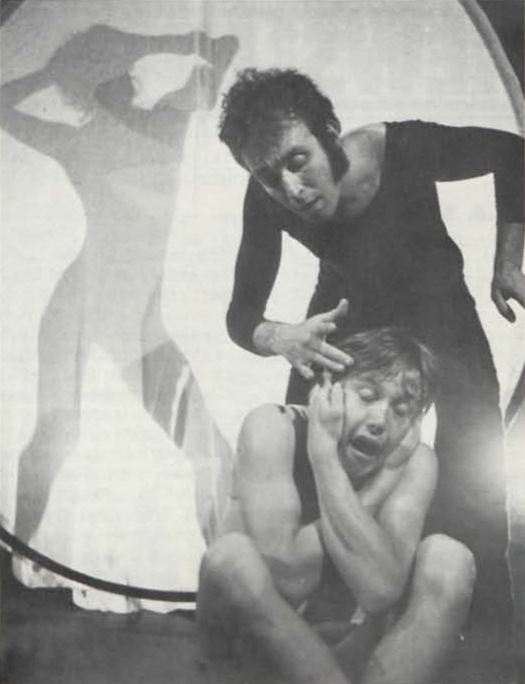news
begin page 205 | ↑ back to topTHE MENTAL TRAVELLER
The Mental Traveller by William Blake, presented by Theatre of Man at the Performance Space, 1350 Waller St., Sat. and Sun. Feb. 9 and 10, 1980.
I was very curious to see what director Fred Curchack would do with his theatrical version of the William Blake poem, The Mental Traveller, an extremely enigmatic and haunting poem about a psychic journey through the unending human cycle of birth, infancy, love, death, rebirth. Throughout runs the recurrent theme of the sexual struggle between women and men and how sexuality both infantilizes and empowers us.
Curchack seems aware of the potent possibilities of this poem and its relation to modern psychological concerns about androgyny, sexual roles, etc. The problem with the piece for me was that instead of giving us his own meditations on this metaphysical fable, he offers us a heavy handed Show and Tell.
First, Curchack recites the poem, then he recites it as a man and a woman “act it out” for us behind round egg-like scrims, and finally all three performers act it out again with variations. I enjoyed the recitation, I found some of the first shadow images— begin page 206 | ↑ back to top clearly meant to be archetypal—captivating, and then I lost interest, because the work simply never went anywhere. It stayed literal—earnest, obvious images presented to us as Big Truths. THe actors sweat and groan to demonstrate sexual passion, they double over to show us they’re old, they arm wrestle to let us know there is a power struggle.
There’s nothing demonic about all this, it simply lacked innovation and relied instead on conveying familiar images via a kind of intense athleticism. Perhaps because he didn’t want to violate the poem, Curchack missed an opportunity to truly expand and explore it, winding up instead with something vaguely analogous to a Classic Comics version of Blake. I’m sorry that Curchack’s considerable imaginative theatrical gifts—effectively demonstrated in other pieces—didn’t take him farther along on his travels with the visionary poet.
Reprinted from The San Francisco Bay Guardian, 31 January 1980.
The Theatre of Man is currently offering The Mental Traveller, based on the William Blake poem of the same name. The poem is written in a spare, balladic form. It is one of the bleakest and most dismal visions of fallen existence. A baby boy is born “in dire woe” and given to an old woman “Who nails him down upon a rock . . . [and] lives upon his shrieks and cries.” Meanwhile, “she grows young as he grows old.” He fades to “an aged shadow” while she grows younger. The cyclical struggle repeats in the opposite direction, with the “Female Babe” growing older and the “Poor Man” younger. Only as they pass each other in age can love and sex be possible.
Adapted by Fred Curchack and heavily influenced by the techniques of physical theater, The Mental Traveller cleverly utilizes a large revolving mobile, from which dangle two life-size see-through screens. Excellent lighting, eerie, primitive instruments and long enveloping shrouds grace the dance-like movements of the woman (Laura Jorgensen), the man (James Bryant), and the traveller (Curchack). After two early and powerful readings of the poem—one acted, the other in darkness—the audience is hurled, without dialogue, through the agony and wonder of solitude, rape, birth, narcissism, self-destruction, sensuality, creation, revenge and eroticism.
Curchack’s traveller at times merely creates and observes. At other times he participates in the countless permutations of relationships. He is alternately accepted and rejected by the two who “Wander in terror and dismay . . . On the desart wild.” However, Curchack’s world becomes too personal, focusing primarily on sexuality and interpersonal dynamics, leaving much of Blake’s mythic insight only half-explored.
Reprinted from City Arts, February 1980, San Francisco.


